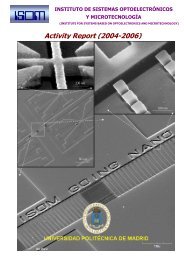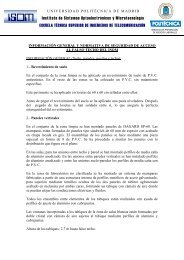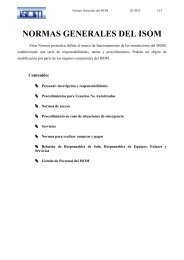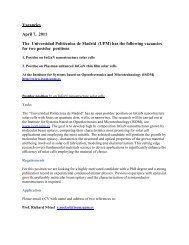Graphene-on-SiC - ISOM
Graphene-on-SiC - ISOM
Graphene-on-SiC - ISOM
You also want an ePaper? Increase the reach of your titles
YUMPU automatically turns print PDFs into web optimized ePapers that Google loves.
TECHNOLOGY SOLAR CELLS<br />
Figure 2 : Light trapping in thick solar cells by total internal reflecti<strong>on</strong> of weakly absorbed light (a). Scanning electr<strong>on</strong> microscope images of a plasm<strong>on</strong>ic<br />
nanoparticle array (b) and a diffracti<strong>on</strong> grating (c) that are both fabricated <strong>on</strong> a solar cell. (d) shows how a plane wave fr<strong>on</strong>t incident <strong>on</strong> a solar cell (left)<br />
is modified by the presence of a plasm<strong>on</strong>ic nanoparticle (center) and a dielectric gratig (right) <strong>on</strong> the rear surface of the solar cell<br />
larger than the critical angle for total internal reflecti<strong>on</strong> at the<br />
absorber-air interface). We work with substrate-based structures<br />
that support a c<strong>on</strong>tinuum of optical modes and feature either<br />
quantum well or dot absorber layers. We employ two light<br />
trapping approaches to enhance the absorpti<strong>on</strong> efficiency<br />
of l<strong>on</strong>g wavelength light in our quantum well/dot solar cells:<br />
plasm<strong>on</strong>ic light trapping and the additi<strong>on</strong> of a diffracti<strong>on</strong> grating<br />
<strong>on</strong> the surface of the solar cell.<br />
Powerful plasm<strong>on</strong>ics<br />
Light trapping is possible using plasm<strong>on</strong>ic nanoparticles – tiny<br />
metallic structures that interact with the incoming light and<br />
exhibit local oscillati<strong>on</strong>s in the density of their free electr<strong>on</strong><br />
gas. One c<strong>on</strong>sequence of this phenomen<strong>on</strong> is that incoming<br />
radiati<strong>on</strong> is scatterred into the solar cell at angles outside the<br />
escape c<strong>on</strong>e.<br />
Good light trapping with plasm<strong>on</strong>ic structures is possible by<br />
exceling in two areas: maximizing the scattering cross-secti<strong>on</strong><br />
of the plasm<strong>on</strong>ic nanoparticles, and realising a high efficiency<br />
for the coupling of scattered light into the substrate. it is vital<br />
to maximise the scattering cross-secti<strong>on</strong>, because this ensures<br />
that the nanoparticles interact with most of the light incident <strong>on</strong><br />
the solar cell and randomise its directi<strong>on</strong>.<br />
Meanwhile, it is critical to achieve a high coupling efficiency of<br />
scattered light into the substrate of the solar cell, because this<br />
minimises reflecti<strong>on</strong> or transmissi<strong>on</strong> losses at each encounter<br />
between the weakly absorbed light and the plasm<strong>on</strong>ic particles.<br />
it is also important to address parasitic losses, which are<br />
inherent to the res<strong>on</strong>ant metallic nanostructures. We form our<br />
plasm<strong>on</strong>ic nanoparticles by depositing a thin silver film <strong>on</strong> the<br />
surface of a finished solar cell and annealing it in a nitrogen<br />
atmosphere. nanoparticle arrays result from the difference in<br />
thermal expansi<strong>on</strong> between the metallic layer and the substrate<br />
(see figure 2).<br />
the fabricati<strong>on</strong> process is relatively easy, since it does not<br />
require modificati<strong>on</strong> of the solar cell fabricati<strong>on</strong> process and is<br />
scalable to large areas. Last year we reported an<br />
8 percent enhancement in the efficiency of a quantum dot<br />
solar cell through the additi<strong>on</strong> of plasm<strong>on</strong>ic light trapping. the<br />
improvement in power predominantly came from an increase in<br />
short-circuit current density (J sc<br />
) by 5.6 percent − the opencircuit<br />
voltage (V oc<br />
) also went up, but just by 0.9 percent.<br />
A good indicator of the effectiveness of a light trapping strategy<br />
is the enhancement in path length. this is defined as the ratio<br />
between the average distance travelled by weakly absorbed<br />
light in a solar cell featuring light trapping, to the distance<br />
travelled in a planar solar cell. Based <strong>on</strong> experimental results<br />
from our plasm<strong>on</strong>ic quantum dot solar cell, we calculate<br />
that this path length enhancement is approximately two at a<br />
wavelength of 1000 nm. We can explain why this value is much<br />
smaller than expected from a good light trapping structure:<br />
Our solar cells are fabricated <strong>on</strong> n + substrates, so free carrier<br />
32 www.compoundsemic<strong>on</strong>ductor.net April/May 2013











